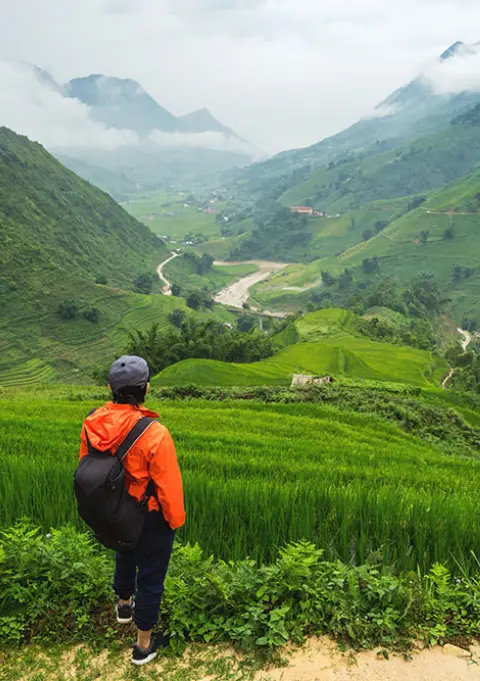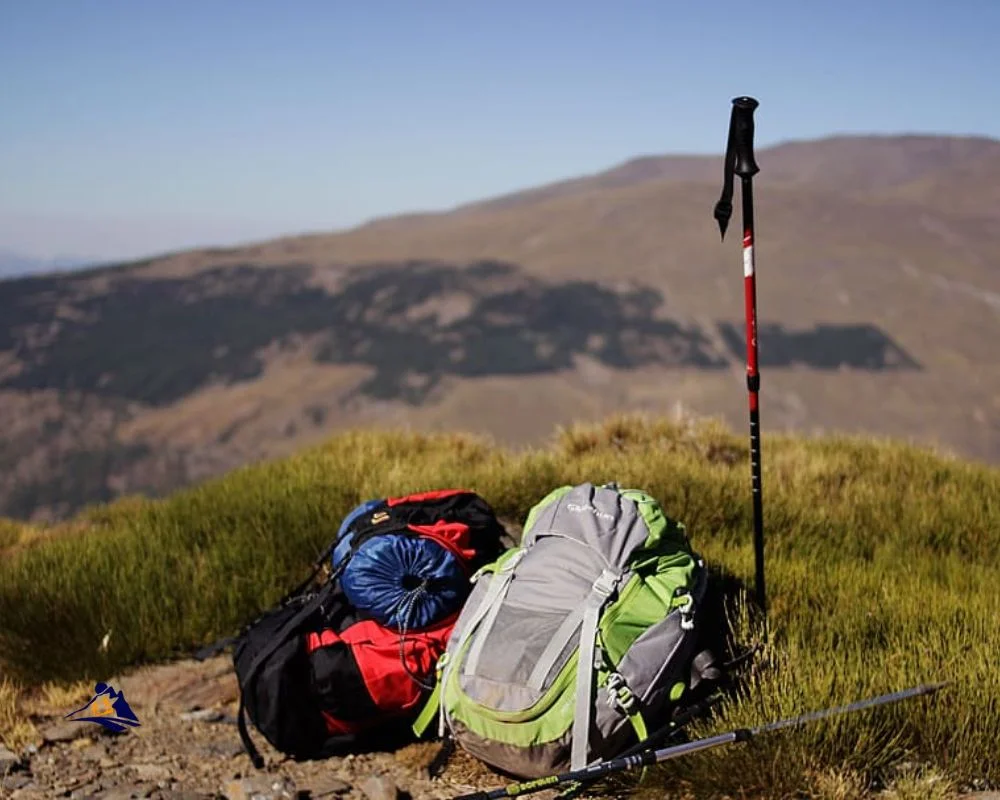Hey, there fellow adventure enthusiasts!
Do you ever find yourself planning a hiking trip, only to be stumped by the questions – ‘How long can I hike in a day?’, How far can you hike in an hour? Can you hike 40 miles in a day? Well, fear not my friends, for we’re about to embark on an exploration of this very topic. As hikers and outdoor lovers, we all crave that feeling of freedom that comes with exploring new paths and conquering challenging trails. But how do we know our limits when it comes to distance? How much ground can we realistically cover before exhaustion sets in or darkness falls?

These are important questions to consider when planning any hiking adventure, so let’s dive into the factors that affect your daily trekking potential.
Table of Contents
TogglePhysical Fitness
Are you ready to hit the trails and explore the great outdoors? Before you start planning your hiking trip, it’s essential to assess your physical fitness level.
Hiking can be a challenging activity that requires endurance, strength, and balance. Make sure you’re physically prepared for the journey ahead by engaging in regular exercise routines that improve cardiovascular health and strengthen leg muscles.

In addition to physical fitness, gear selection is also crucial when planning a successful hike. Invest in high-quality hiking shoes with proper ankle support and traction on slippery terrain. Choose breathable clothing layers that will keep you warm but won’t overheat as you progress through different elevations. Nutrition planning is equally important; bring lightweight energy-dense foods like nuts or dried fruit to keep your body fueled throughout the day.
With these tips in mind, let’s dive into exploring just how long one should hike in a day based on varying terrains!
Terrain Type
When it comes to terrain type, soft ground is usually easy to navigate and can be hiked for longer distances in a day. Rocky paths, on the other hand, require more energy and can be tiring; however, they can be great for experienced hikers looking for a challenge. Uneven surfaces can be tricky, so caution is advised – it’s best to stick to paths you know well when trekking on this type of terrain!
Sapa 1 Day Tours

- 1 day experience
- Moderate to challenging
- Cultural immersion & active adventure
- Rice fields, valleys & villages
- Private tours
- Vegan-friendly
Sapa 2 Day Tours

- 2 days 1 night experience
- Moderate to challenging
- Cultural immersion & active adventure
- Mountains, valleys, rice fields and villages
- Private tours
- Vegan-friendly
Sapa 3 Day Tours

- 3 days 2 night experience
- Moderate to challenging
- Cultural immersion & active adventure
- Mountains, valley, rice fields & villages
- Private tours
- Vegan-friendly
Sapa 4 Day Tours

- 4 days 3 night experience
- Moderate to challenging
- Cultural immersion & active adventure
- Mountains, valleys, rice fields & villages
- Private tours – Less Touristic
- Vegan-friendly
Soft Ground
When it comes to the terrain type, the soft ground can be a blessing or curse for hikers. On one hand, walking on plush earth can offer a cushioning effect that reduces the impact on joints and muscles, making for a more comfortable journey overall. However, this also means that every step taken requires more effort as you sink into the ground with each stride. This is especially true when packing supplies on your back and choosing footwear that isn’t suited for softer surfaces.

It’s important to strike a balance between comfort and practicality when hiking on soft ground, taking care not to overexert yourself in pursuit of speed or distance covered. Remember, the beauty of nature should be enjoyed at your own pace – there’s no need to rush towards any particular destination!
Rocky Paths
Now, let’s talk about another terrain type that can make or break a hiking journey – rocky paths. These rugged trails offer their own unique set of challenges and rewards for hikers who choose to tackle them. On one hand, the rough surface provides excellent traction and stability while navigating steep inclines and declines. However, this also means that gear selection and footwear choice become even more crucial in ensuring a safe and comfortable trek.

When preparing for a hike on rocky paths, it’s important to invest in sturdy boots with ample ankle support and durable soles designed for grip on uneven surfaces. Additionally, lightweight yet protective gear such as knee pads or gloves may come in handy when scrambling over jagged rocks or boulders.
But the greatest reward of conquering a rocky path lies not just in the physical challenge but also in the stunning vistas that await at the end of the trail. So take your time, enjoy the scenery, and don’t forget to snap some photos along the way!
Uneven Surfaces
As hikers, we know that every terrain type presents its unique challenges and rewards. One such challenge is navigating through uneven surfaces, which can range from rocky paths to root-strewn trails. While these rugged terrains may test our balance and stability, they also offer a thrilling sense of adventure as we push ourselves to conquer the natural obstacles in our way.
To tackle these uneven surfaces, proper footwear choice becomes even more crucial. Investing in boots with sturdy ankle support and durable soles designed for grip on unpredictable surfaces will help prevent injuries and ensure a comfortable journey.

Additionally, keeping hydration levels up is key – balancing your electrolytes while traversing rough terrain can be tricky but it’s essential to stay energized and focused.
But despite these challenges, hiking through uneven surfaces offers some of the most breathtaking views nature has to offer. So let’s lace up our boots, grab our gear, and embark on an adventure like no other – one that leads us down winding trails full of twists and turns toward stunning vistas beyond compare.
Weather Conditions
Now that we have discussed the terrain type, let’s move on to another important factor in determining how long you can hike in a day: weather conditions. Sun exposure and water access are two key factors to consider when planning your route. Firstly, sun exposure is something to keep in mind, especially during the hotter months. Be sure to plan your hiking schedule around the times of day when the sun is not at its peak intensity. This will help prevent dehydration, fatigue, and other heat-related illnesses. Additionally, it’s recommended that hikers wear protective clothing such as hats or sunglasses to avoid direct UV rays.

Secondly, always make sure you have enough water access throughout your journey. Dehydration is one of the biggest dangers for hikers, so be prepared with plenty of water or ways to filter drinking water from natural sources along the way. Consider carrying a hydration pack or investing in lightweight filtration systems – this will ensure you remain hydrated throughout your trip.
As we continue our discussion on how long one can hike in a day, it’s crucial to take into account elevation gain – an aspect that directly impacts stamina and endurance while trekking through mountainous regions.
Sapa 1 Day Tours

- 1 day experience
- Moderate to challenging
- Cultural immersion & active adventure
- Rice fields, valleys & villages
- Private tours
- Vegan-friendly
Sapa 2 Day Tours

- 2 days 1 night experience
- Moderate to challenging
- Cultural immersion & active adventure
- Mountains, valleys, rice fields and villages
- Private tours
- Vegan-friendly
Sapa 3 Day Tours

- 3 days 2 night experience
- Moderate to challenging
- Cultural immersion & active adventure
- Mountains, valley, rice fields & villages
- Private tours
- Vegan-friendly
Sapa 4 Day Tours

- 4 days 3 night experience
- Moderate to challenging
- Cultural immersion & active adventure
- Mountains, valleys, rice fields & villages
- Private tours – Less Touristic
- Vegan-friendly
Elevation Gain
As a hiker, it’s important to understand the impact of elevation gain on your hiking ability. Depending on the terrain, you may be able to hike for hours with minimal elevation change or find yourself struggling after just a few miles uphill.
When planning your distance for the day, consider both the overall elevation gain and how steep these changes are. For example, if you’re planning a 10-mile hike that has a cumulative elevation gain of 2,000 feet, expect to take longer than if you were walking 10 miles along flat ground.

Your gear selection and packing strategy can also affect how far you’ll be able to hike in a single day. If you have lightweight equipment and only carry what is necessary, you will feel less weighed down and be able to move more quickly over long distances. On the other hand, carrying heavy loads or unnecessary items will slow you down and make it difficult to cover as much terrain each day.
Take time before your trip begins to evaluate your gear needs and pack strategically so that every item serves a purpose without weighing you down unnecessarily.
Sapa 1 Day Tours

- 1 day experience
- Moderate to challenging
- Cultural immersion & active adventure
- Rice fields, valleys & villages
- Private tours
- Vegan-friendly
Sapa 2 Day Tours

- 2 days 1 night experience
- Moderate to challenging
- Cultural immersion & active adventure
- Mountains, valleys, rice fields and villages
- Private tours
- Vegan-friendly
Sapa 3 Day Tours

- 3 days 2 night experience
- Moderate to challenging
- Cultural immersion & active adventure
- Mountains, valley, rice fields & villages
- Private tours
- Vegan-friendly
Sapa 4 Day Tours

- 4 days 3 night experience
- Moderate to challenging
- Cultural immersion & active adventure
- Mountains, valleys, rice fields & villages
- Private tours – Less Touristic
- Vegan-friendly
As we’ve seen, understanding elevation gain and making smart choices about gear selection and packing strategy can greatly impact how far you can hike in one day. But there’s another factor at play: the amount of weight carried. Let’s explore this topic further…
Amount Of Weight Carried
Now that we’ve talked about elevation gain, let’s move on to another important factor in determining how long you can hike in a day: the amount of weight you’re carrying. It’s no secret that the heavier your backpack is, the harder it will be to maintain a steady pace for an extended peperiodThat’s why gear selection is crucial when planning a hiking trip.
First and foremost, make sure you have all the essentials without overpacking. Consider investing in lightweight equipment and clothing layers that can easily be added or removed as needed. This not only reduces overall weight but also allows for better temperature regulation throughout the day. When choosing food items, opt for high-calorie snacks that are compact and easy to carry.

With careful consideration of your gear selection, you can lighten your load and increase your endurance on the trail. Now that we’ve covered gear selection and weight management, let’s talk about the availability of rest stops along your route. While some trails may have designated areas with benches or shelters, others may require more strategic planning for breaks.
Take note of any natural landmarks such as streams or rock formations where you can take a quick break and refuel before continuing. Keep in mind that frequent short rests are often more beneficial than fewer longer ones – they give both your body and mind a chance to recharge without slowing down momentum too much.
Sapa 1 Day Tours

- 1 day experience
- Moderate to challenging
- Cultural immersion & active adventure
- Rice fields, valleys & villages
- Private tours
- Vegan-friendly
Sapa 2 Day Tours

- 2 days 1 night experience
- Moderate to challenging
- Cultural immersion & active adventure
- Mountains, valleys, rice fields and villages
- Private tours
- Vegan-friendly
Sapa 3 Day Tours

- 3 days 2 night experience
- Moderate to challenging
- Cultural immersion & active adventure
- Mountains, valley, rice fields & villages
- Private tours
- Vegan-friendly
Sapa 4 Day Tours

- 4 days 3 night experience
- Moderate to challenging
- Cultural immersion & active adventure
- Mountains, valleys, rice fields & villages
- Private tours – Less Touristic
- Vegan-friendly
By considering these factors alongside elevation gain and weight management, you’ll be well-equipped to plan out an enjoyable and successful hiking adventure!
Availability Of Rest Stops
Rest stops are like oases in the middle of a vast and arid desert. They can provide much-needed relief to hikers who have been trudging along for hours, with their gear selection weighing them down. Taking breaks at regular intervals is essential not just for physical rest but also for mental rejuvenation.

It’s important to remember that hiking isn’t a sprint; it’s all about pacing strategies. When deciding how long you can hike in a day and how many miles a day you can get, keep in mind the availability of rest stops along your route. Plan and consider factors like terrain, weather conditions, and distance between resting points.
Having a clear idea of where and when you’ll be taking breaks will help you pace yourself better and prevent burnout. Remember to take advantage of natural features such as streams or rocks for short breaks if needed – every little bit counts!
Conclusion
When it comes to hiking, the length of your trek is determined by various factors. Your physical fitness level plays a significant role in determining how far you can go on a particular day. If you’re an experienced hiker with good stamina, then covering 20-25 miles might be possible for you. However, if you’re just starting or have any underlying health issues, then it’s best to start slow and build up gradually.
The terrain type that you’ll encounter on your hike is also crucial in deciding how long you can walk. A flat trail will allow you to cover more ground than one with steep inclines and declines. Similarly, weather conditions like heat waves or heavy rains can affect your pace as well.

Elevation gain is another factor that determines how much distance you can cover per day. Going uphill takes more energy and time than walking downhill or on level ground. The amount of weight carried also affects your endurance; carrying a heavy backpack reduces your speed significantly. Rest stops are vital during hikes as they provide opportunities to recover and refuel before continuing the journey. Having access to rest areas along the way helps ensure that fatigue doesn’t set in too quickly.
In conclusion, there’s no definitive answer to the question of how long someone can hike in a day because so many variables come into play. The most important thing is to listen to your body and adjust accordingly while keeping these factors in mind: physical fitness, terrain type/weather conditions/elevation gain/amount of weight carried/rest stop availability all remaining critical considerations for anyone taking on such adventures!
With some preparation beforehand – including proper gear choices like sturdy boots – even hyperbole-chasing adventurers capable of journeys beyond their wildest imaginations won’t find themselves caught off guard!
Sapa 1 Day Tours

- 1 day experience
- Moderate to challenging
- Cultural immersion & active adventure
- Rice fields, valleys & villages
- Private tours
- Vegan-friendly
Sapa 2 Day Tours

- 2 days 1 night experience
- Moderate to challenging
- Cultural immersion & active adventure
- Mountains, valleys, rice fields and villages
- Private tours
- Vegan-friendly
Sapa 3 Day Tours

- 3 days 2 night experience
- Moderate to challenging
- Cultural immersion & active adventure
- Mountains, valley, rice fields & villages
- Private tours
- Vegan-friendly
Sapa 4 Day Tours

- 4 days 3 night experience
- Moderate to challenging
- Cultural immersion & active adventure
- Mountains, valleys, rice fields & villages
- Private tours – Less Touristic
- Vegan-friendly





